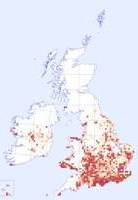The Pyramidal Orchid is one of our commonest and most widespread wild orchids and, in favoured positions, it will carpet the ground from late June to early August. The name 'pyramidal' comes from the shape of the flowerhead when the flowers first start to open from the bottom, creating a clearly defined cone shape. As more flowers open the shape changes and becomes more oval. Anacamptis pyramidals can grow quite tall - up to 75cm - and is not easily mistaken for any of the other species that appear at the same time. This orchid can grow in a wide variety of habitats but does best where there is plenty of chalk in the soil. It is tolerant of both short sward and long rank grasses. Suitable habitats include clifftops, limestone pavement areas and sand dunes. Pyramidal Orchid is also found in many other European countries.
| Distribution Map | Key Features | |
 |
Records for the Pyramidal Orchid from BSBI are shown on the map with most recent in front. (Hover the mouse over the small map to expand it.) |
Plant: 20-60cm, occasionally to 75cm. Stem green and slender with a slight but distinct angular bend just beneath the flowers. There are 2-3 brown sheaths at the stem base. |
Image Gallery for Pyramidal Orchid Anacamptis pyramidalis
| Pollination | Taxonomy & Hybrids |
| Pyramidal Orchids are pollinated by night- and day-flying moths and butterflies which are rewarded by nectar. This orchid can also propagate vegetatively via tubers that develop at the end of short rhizomes. |
Until recently the Pyramidal Orchid was the only British species in the genus Anacamptis; however, as a result of recent genetic studies, it has now been joined by the Green-winged Orchid Anacamptis morio and the Loose-flowered Orchid Anacamptis laxiflora. |
Articles about Pyramidal Orchid in JHOS
-
